Fran Baker's Blog, page 4
September 17, 2012
Monday, September 17, 1934
Rode to school with Daddy. Changed lockers. Ollie and Mrs. Raifert over for supper.
 Beethoven's 5th -The main theme of the third movement
Beethoven's 5th -The main theme of the third movement
September 17, 1934: First 33 1/3 rpm recording released (Beethoven's 5th)

 Beethoven's 5th -The main theme of the third movement
Beethoven's 5th -The main theme of the third movementSeptember 17, 1934: First 33 1/3 rpm recording released (Beethoven's 5th)
Published on September 17, 2012 04:45
September 16, 2012
Sunday, September 16, 1934
Went to Sunday school and church. Daddy bet $2. Lost. Pauline and I went to the show. Saw "Golddiggers of 1933" and "Gambling Lady." We wore our green dresses.
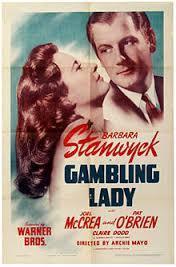 Theatrical Release Poster
Theatrical Release Poster
Drama
Run time: 66 minutes
Released March 31, 1934
Plot Summary:
Lady Lee (Barbara Stanwyck), gambler's daughter, plies her trade while pondering the proposal of a social-register suitor (Joel McCrea).

 Theatrical Release Poster
Theatrical Release PosterDrama
Run time: 66 minutes
Released March 31, 1934
Plot Summary:
Lady Lee (Barbara Stanwyck), gambler's daughter, plies her trade while pondering the proposal of a social-register suitor (Joel McCrea).
Published on September 16, 2012 04:45
September 15, 2012
Saturday, September 15, 1934
Pauline came down a while. Went to store. Took some dishes over to Carrie's for Mrs. Raifert. Read a while this evening.
 Lotus Leaf quilting pattern
Lotus Leaf quilting pattern
This small quilting pattern can be used as a single section. Or put all four corners together, you get an interesting square with points at each corner. Combined, it fits a 10" to 12" square. Published in The Kansas City Star on Sept. 15, 1934.
 Lotus Leaf quilting pattern
Lotus Leaf quilting patternThis small quilting pattern can be used as a single section. Or put all four corners together, you get an interesting square with points at each corner. Combined, it fits a 10" to 12" square. Published in The Kansas City Star on Sept. 15, 1934.
Published on September 15, 2012 04:45
September 14, 2012
Wednesday, September 19, 1934
Note: Ruth didn't write in her diary today.
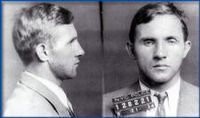 Bruno Richard Hauptmann (November 26, 1899 – April 3, 1936)
Bruno Richard Hauptmann (November 26, 1899 – April 3, 1936)
September 19, 1934: Arrested for Lindbergh kidnapping and murder
A German ex-convict, Hauptmann was sentenced to death for the abduction and murder of the 20-month-old son of Charles Lindbergh and Anne Morrow Lindbergh. The Lindberg kidnapping became known as "The Crime of the Century".

 Bruno Richard Hauptmann (November 26, 1899 – April 3, 1936)
Bruno Richard Hauptmann (November 26, 1899 – April 3, 1936)September 19, 1934: Arrested for Lindbergh kidnapping and murder
A German ex-convict, Hauptmann was sentenced to death for the abduction and murder of the 20-month-old son of Charles Lindbergh and Anne Morrow Lindbergh. The Lindberg kidnapping became known as "The Crime of the Century".
Published on September 14, 2012 23:45
Friday, September 14, 1934
Rode to school with Daddy. He came after us. Ruth Ray and Pauline and I went to the show. Saw "Kennel Murder Case" and "The Fugitive."
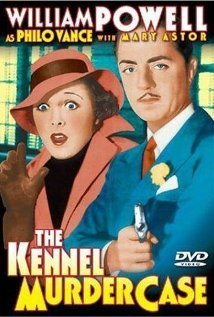 The Kennel Murder Case movie poster (1933)
The Kennel Murder Case movie poster (1933)
Starring William Powell, Mary Astor and Eugene Pallette
Directed by Michael Curtiz
Genre: Mystery
Run time: 73 minutes
Release Date: October 28, 1933
Plot Summary:
Philo Vance, accompanied by his prize-losing Scottish terrier, investigates the locked-room murder of a prominent and much-hated collector whose broken Chinese vase provides an important clue.

 The Kennel Murder Case movie poster (1933)
The Kennel Murder Case movie poster (1933)Starring William Powell, Mary Astor and Eugene Pallette
Directed by Michael Curtiz
Genre: Mystery
Run time: 73 minutes
Release Date: October 28, 1933
Plot Summary:
Philo Vance, accompanied by his prize-losing Scottish terrier, investigates the locked-room murder of a prominent and much-hated collector whose broken Chinese vase provides an important clue.
Published on September 14, 2012 04:45
September 13, 2012
Thursday, September 13, 1934
Went to school today. Tonight got lessons all evening until I went to bed. Sure had a lot to do.

Published on September 13, 2012 04:45
September 12, 2012
Wednesday, September 12, 1934
Got my locker at school. It was hot today. Pauline and I walked home together.
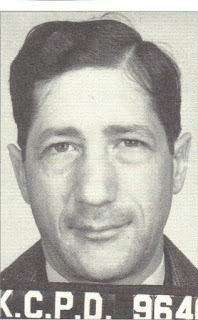 Gaetano Lococo (1895-1993)AKA "Tano" or "Thomas" Lococo was a mobster identified as one of the "Five Iron Men of Kansas City." In his early years he was known as an enforcer with the Kansas City crime family. Later on, he controlled an interest in several illegal gambling establishments. In March 1950 Lococo was identified at a meeting of U.S. and Sicilian mobsters at a Tiajuana, Mexico hotel. When local Mexican police found out about the meeting, they ended it prematurely. Less than a month after the conference, Kansas City boss Charles Binaggio and underboss Charlie Gargotta were assassinated. It was speculated during the Kefauver hearings on organized crime a few years later that the decision to whack Binaggio had been made at the Tiajuana meeting. Gaetano Lococo died of natural causes at the age of 98.
Gaetano Lococo (1895-1993)AKA "Tano" or "Thomas" Lococo was a mobster identified as one of the "Five Iron Men of Kansas City." In his early years he was known as an enforcer with the Kansas City crime family. Later on, he controlled an interest in several illegal gambling establishments. In March 1950 Lococo was identified at a meeting of U.S. and Sicilian mobsters at a Tiajuana, Mexico hotel. When local Mexican police found out about the meeting, they ended it prematurely. Less than a month after the conference, Kansas City boss Charles Binaggio and underboss Charlie Gargotta were assassinated. It was speculated during the Kefauver hearings on organized crime a few years later that the decision to whack Binaggio had been made at the Tiajuana meeting. Gaetano Lococo died of natural causes at the age of 98.

 Gaetano Lococo (1895-1993)AKA "Tano" or "Thomas" Lococo was a mobster identified as one of the "Five Iron Men of Kansas City." In his early years he was known as an enforcer with the Kansas City crime family. Later on, he controlled an interest in several illegal gambling establishments. In March 1950 Lococo was identified at a meeting of U.S. and Sicilian mobsters at a Tiajuana, Mexico hotel. When local Mexican police found out about the meeting, they ended it prematurely. Less than a month after the conference, Kansas City boss Charles Binaggio and underboss Charlie Gargotta were assassinated. It was speculated during the Kefauver hearings on organized crime a few years later that the decision to whack Binaggio had been made at the Tiajuana meeting. Gaetano Lococo died of natural causes at the age of 98.
Gaetano Lococo (1895-1993)AKA "Tano" or "Thomas" Lococo was a mobster identified as one of the "Five Iron Men of Kansas City." In his early years he was known as an enforcer with the Kansas City crime family. Later on, he controlled an interest in several illegal gambling establishments. In March 1950 Lococo was identified at a meeting of U.S. and Sicilian mobsters at a Tiajuana, Mexico hotel. When local Mexican police found out about the meeting, they ended it prematurely. Less than a month after the conference, Kansas City boss Charles Binaggio and underboss Charlie Gargotta were assassinated. It was speculated during the Kefauver hearings on organized crime a few years later that the decision to whack Binaggio had been made at the Tiajuana meeting. Gaetano Lococo died of natural causes at the age of 98.
Published on September 12, 2012 04:45
September 11, 2012
Tuesday, September 11, 1934
Went to school. Got lessons done, then Pauline, Nadine and I went to church. They had some slides.
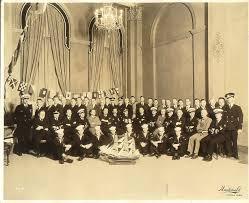 Region 8 Sea Scouts BSA
Region 8 Sea Scouts BSA
September 11, 1934 - Lincoln, Nebraska
Sea Scouting is a coed outdoor program for young adults 14-20 years old and their adult advisors.
The Sea Scout Promise follows:
As a Sea Scout I promise to do my best:
To guard against water accidents;
To know the location and proper use of the lifesaving devices on every boat I board;
To be prepared to render aid to those in need;
To seek to preserve the motto of the sea, Women and children first.

 Region 8 Sea Scouts BSA
Region 8 Sea Scouts BSASeptember 11, 1934 - Lincoln, Nebraska
Sea Scouting is a coed outdoor program for young adults 14-20 years old and their adult advisors.
The Sea Scout Promise follows:
As a Sea Scout I promise to do my best:
To guard against water accidents;
To know the location and proper use of the lifesaving devices on every boat I board;
To be prepared to render aid to those in need;
To seek to preserve the motto of the sea, Women and children first.
Published on September 11, 2012 04:45
September 10, 2012
Monday, September 10, 1934
Went to school. Rode with Pauline. Kind of cold. Got my lessons done. Pauline and I went walking in evening.
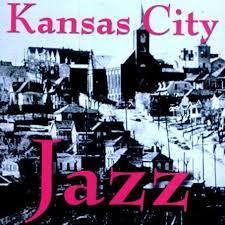 Kansas City jazz, which came into its own in the 1920s and 1930s, is distinguished by the following musical elements:
Kansas City jazz, which came into its own in the 1920s and 1930s, is distinguished by the following musical elements:
A preference for a 4/4 beat over the 2/4 beat found in other jazz styles of the time. As a result, Kansas City jazz had a more relaxed, fluid sound than other jazz styles.
Extended soloing. Fueled by the non-stop nightlife under Political Boss Tom Pendergast, Kansas City jam sessions went on well past sunrise, fostering a highly competitive atmosphere and a unique jazz culture in which the goal was to "say something" with one's instrument, rather than simply show off one's technique. It was not uncommon for one "song" to be performed for several hours, with the best musicians often soloing for dozens of choruses at a time.
So-called "head arrangements". The KC big bands often played by memory, composing and arranging the music collectively, rather than sight-reading as other big bands of the time did. This further contributed to the loose, spontaneous Kansas City sound.
A heavy blues influence, with KC songs often based around a 12-bar blues structure, rather than the 8-bar jazz standard.
One of the most recognizable characteristics of Kansas City jazz is frequent, elaborate riffing by the different sections. Riffs were often created - or even improvised - collectively, and took many forms: a) one section riffing alone, serving as the main focus of the music; b) one section riffing behind a soloist, adding excitement to the song; or c) two or more sections riffing in counterpoint, creating an exciting hard-swinging sound. The Count Basie signature tunes "One O'Clock Jump" and "Jumpin' at the Woodside", for example, are simply collections of complex riffs, memorized in a head arrangement, and punctuated with solos. Glenn Miller's famous swing anthem "In the Mood" closely follows the Kansas City pattern of riffing sections, and is a good example of the Kansas City style after it had been exported to the rest of the world.

 Kansas City jazz, which came into its own in the 1920s and 1930s, is distinguished by the following musical elements:
Kansas City jazz, which came into its own in the 1920s and 1930s, is distinguished by the following musical elements: A preference for a 4/4 beat over the 2/4 beat found in other jazz styles of the time. As a result, Kansas City jazz had a more relaxed, fluid sound than other jazz styles.
Extended soloing. Fueled by the non-stop nightlife under Political Boss Tom Pendergast, Kansas City jam sessions went on well past sunrise, fostering a highly competitive atmosphere and a unique jazz culture in which the goal was to "say something" with one's instrument, rather than simply show off one's technique. It was not uncommon for one "song" to be performed for several hours, with the best musicians often soloing for dozens of choruses at a time.
So-called "head arrangements". The KC big bands often played by memory, composing and arranging the music collectively, rather than sight-reading as other big bands of the time did. This further contributed to the loose, spontaneous Kansas City sound.
A heavy blues influence, with KC songs often based around a 12-bar blues structure, rather than the 8-bar jazz standard.
One of the most recognizable characteristics of Kansas City jazz is frequent, elaborate riffing by the different sections. Riffs were often created - or even improvised - collectively, and took many forms: a) one section riffing alone, serving as the main focus of the music; b) one section riffing behind a soloist, adding excitement to the song; or c) two or more sections riffing in counterpoint, creating an exciting hard-swinging sound. The Count Basie signature tunes "One O'Clock Jump" and "Jumpin' at the Woodside", for example, are simply collections of complex riffs, memorized in a head arrangement, and punctuated with solos. Glenn Miller's famous swing anthem "In the Mood" closely follows the Kansas City pattern of riffing sections, and is a good example of the Kansas City style after it had been exported to the rest of the world.
Published on September 10, 2012 04:45
September 9, 2012
Sunday, September 9, 1934
I went to Sunday school today by myself. Mother didn't feel well enough to go. It rained hard tonight. Read and studied. Ruth Ray and Nadine down.
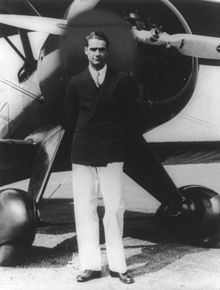 Howard Robard Hughes, Jr. (December 24, 1905 – April 5, 1976)
Howard Robard Hughes, Jr. (December 24, 1905 – April 5, 1976)
An American business magnate, investor, aviator, aerospace engineer, film maker and philanthropist, Hughes was one of the wealthiest people in the world. As a maverick film producer, he gained prominence in Hollywood from the late 1920s, making big-budget and often, controversial films like The Racket (1928), Hell's Angels (1930), Scarface (1932) and The Outlaw (1943).
Hughes was one of the most influential aviators in history: he set multiple world air speed records, built the Hughes H-1 Racer and H-4 "Hercules" (better known to history as the "Spruce Goose" aircraft), and acquired and expanded Trans World Airlines, which would later on merge with American Airlines. Hughes is also remembered for his eccentric behavior and reclusive lifestyle in later life, caused in part by a worsening obsessive–compulsive disorder and chronic pain. His legacy is maintained through the Howard Hughes Medical Institute.

 Howard Robard Hughes, Jr. (December 24, 1905 – April 5, 1976)
Howard Robard Hughes, Jr. (December 24, 1905 – April 5, 1976)An American business magnate, investor, aviator, aerospace engineer, film maker and philanthropist, Hughes was one of the wealthiest people in the world. As a maverick film producer, he gained prominence in Hollywood from the late 1920s, making big-budget and often, controversial films like The Racket (1928), Hell's Angels (1930), Scarface (1932) and The Outlaw (1943).
Hughes was one of the most influential aviators in history: he set multiple world air speed records, built the Hughes H-1 Racer and H-4 "Hercules" (better known to history as the "Spruce Goose" aircraft), and acquired and expanded Trans World Airlines, which would later on merge with American Airlines. Hughes is also remembered for his eccentric behavior and reclusive lifestyle in later life, caused in part by a worsening obsessive–compulsive disorder and chronic pain. His legacy is maintained through the Howard Hughes Medical Institute.
Published on September 09, 2012 04:45



